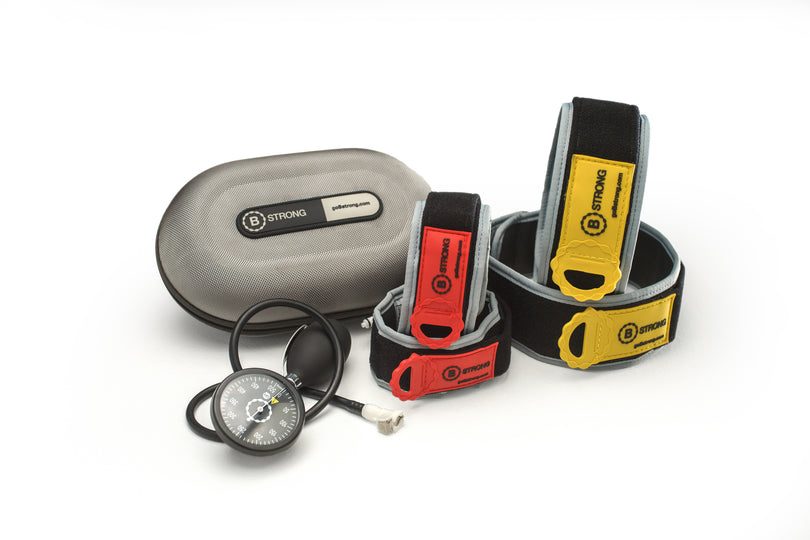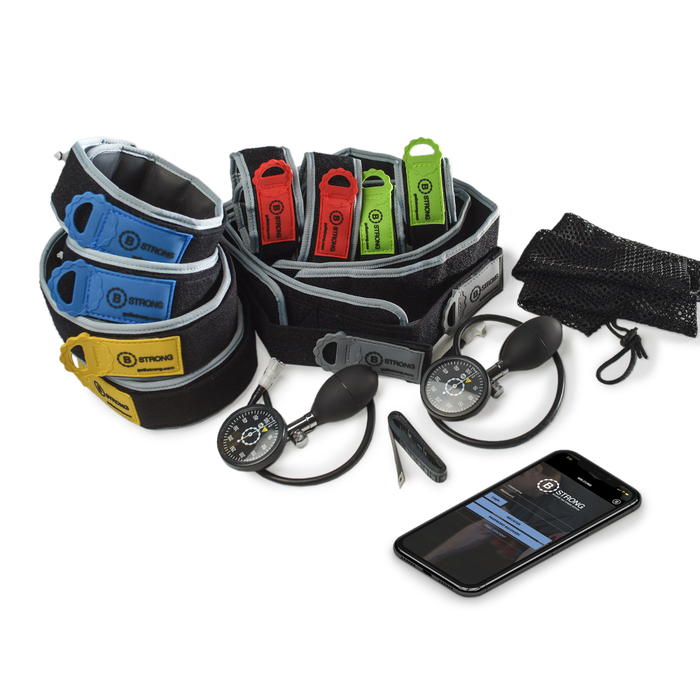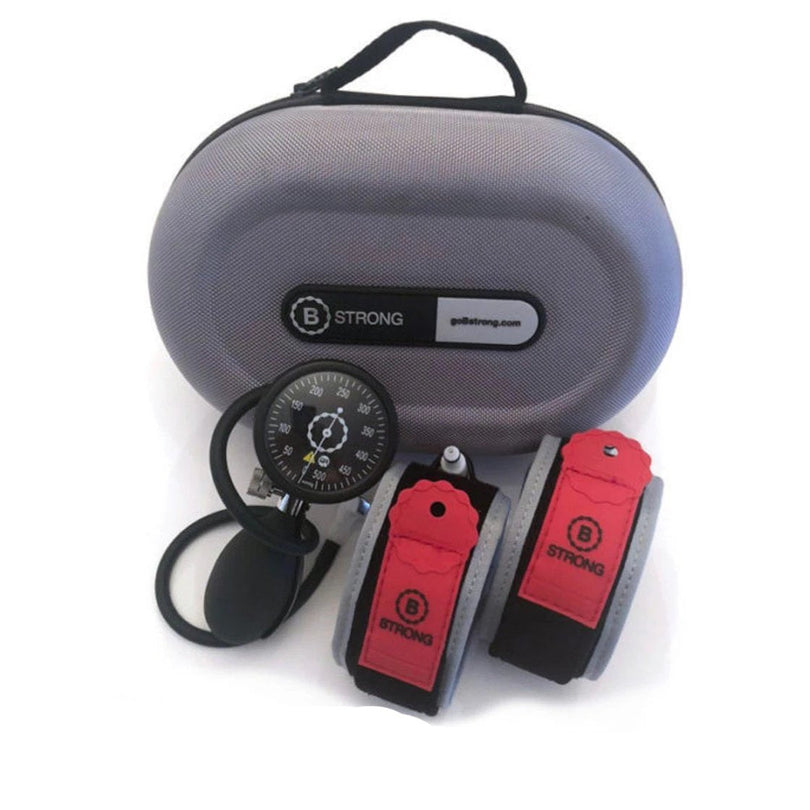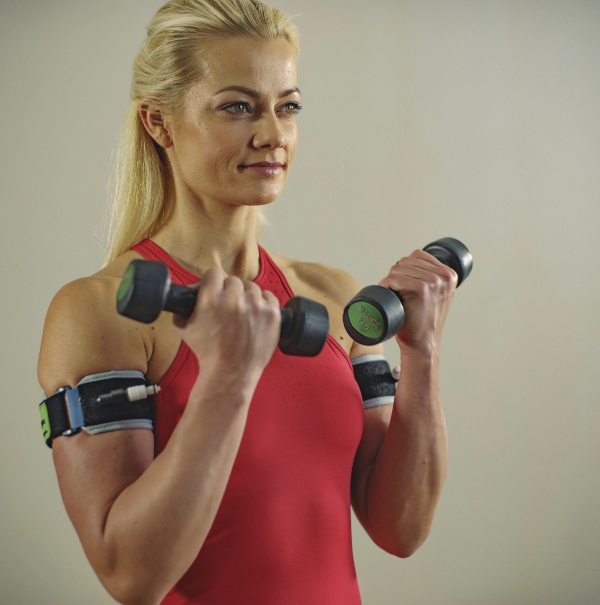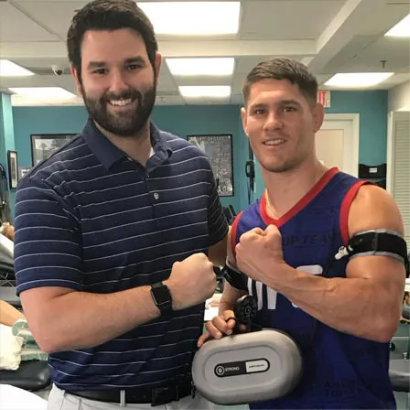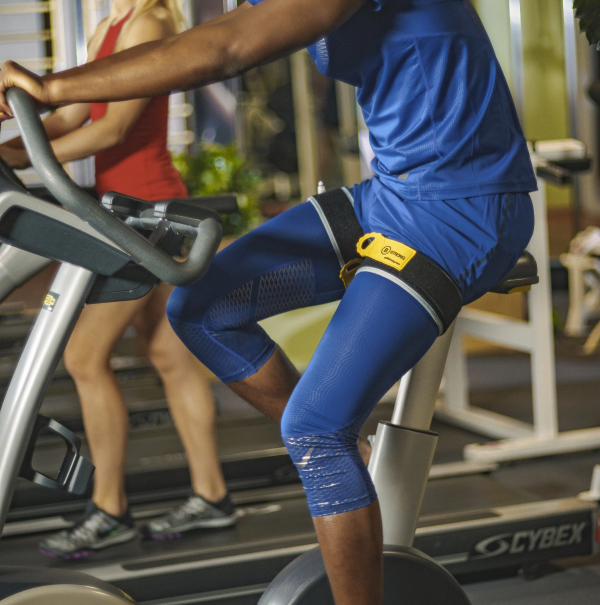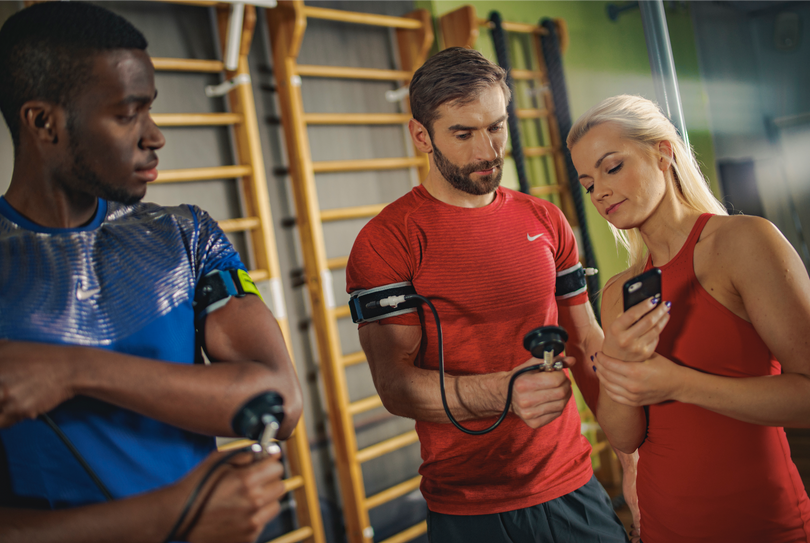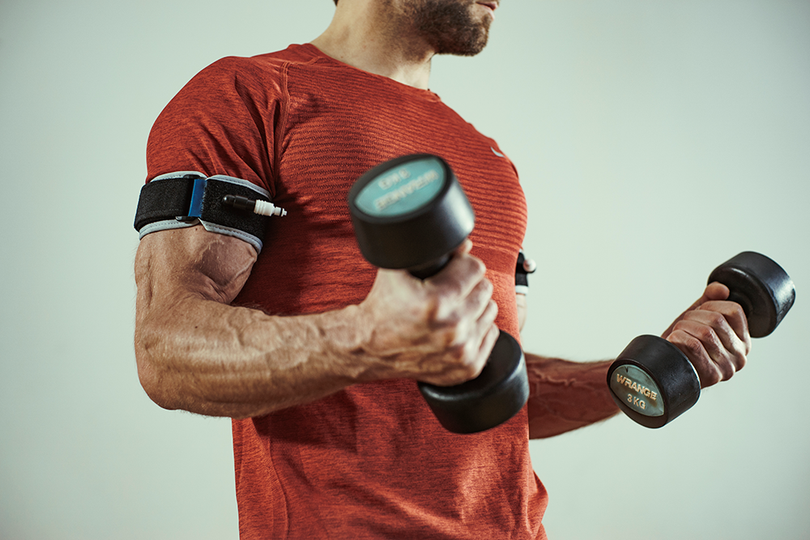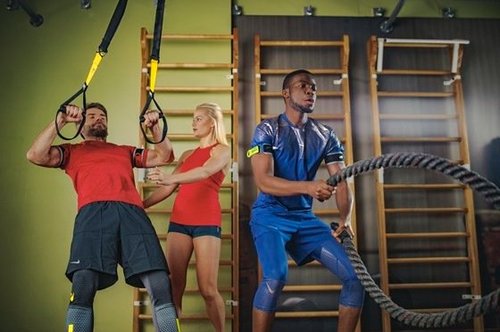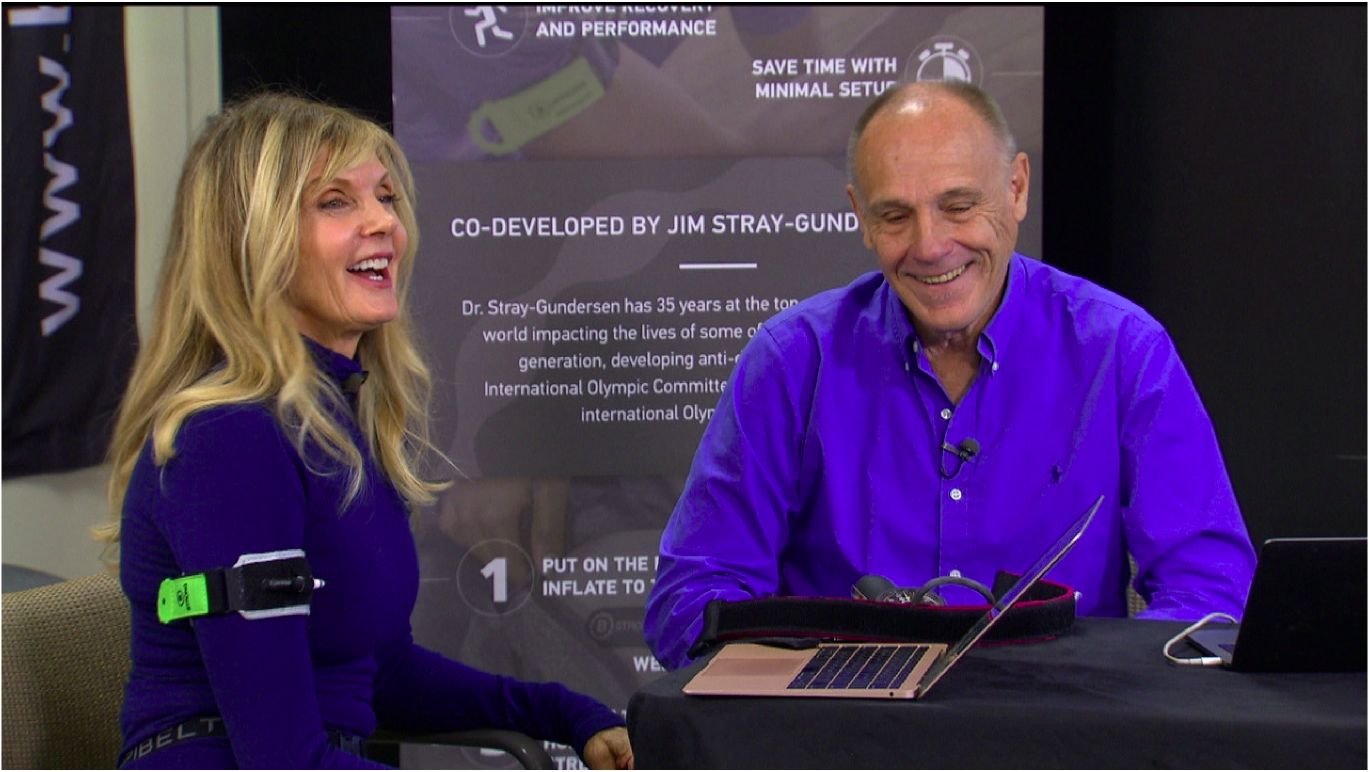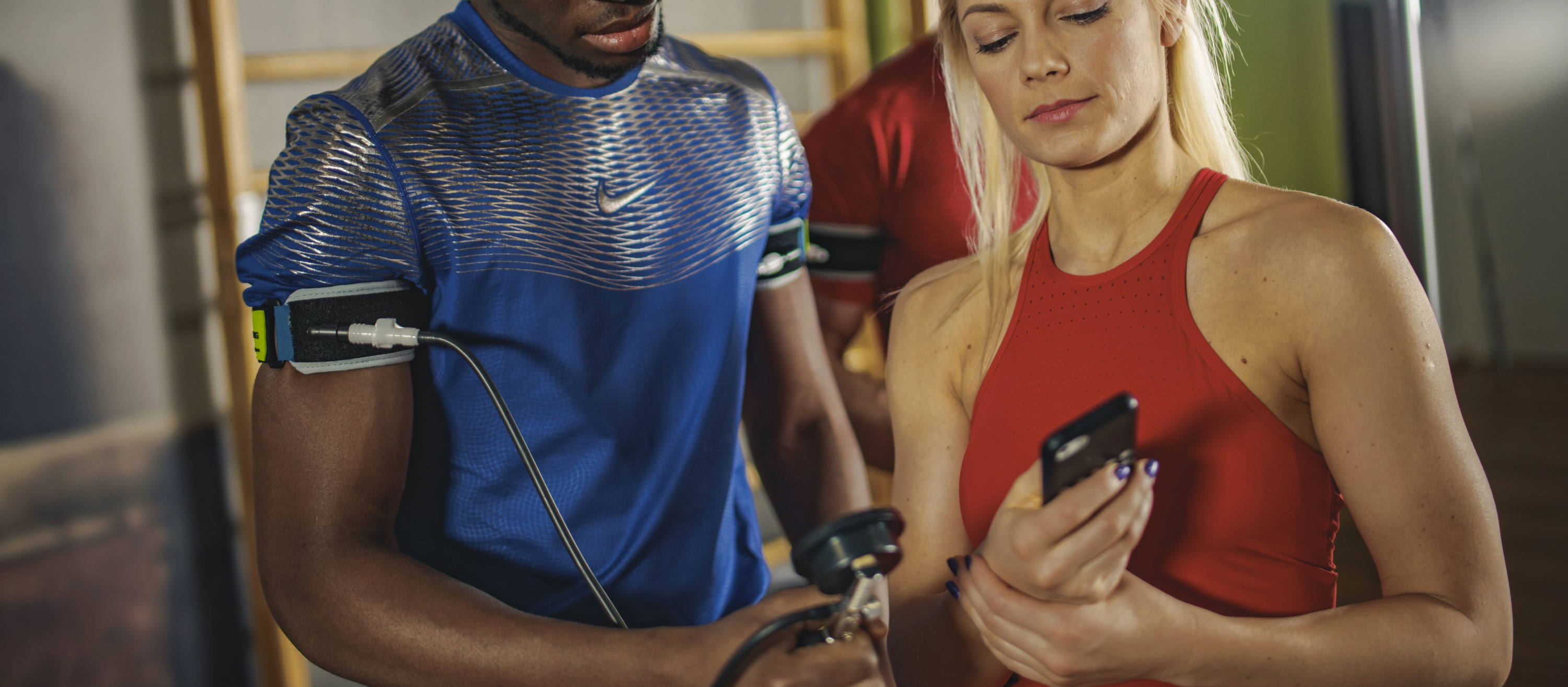I have been experimenting with Blood Flow Restriction (BFR) while exercising to help patients achieve that aesthetic look, wellness sensation, and offer services that improve fitness and post injury recovery.
I’ve demonstrated that performing exercise with B Strong BFR bands helps improve my deep sleep and I’m beginning to notice improved heart rate variability based on my Oura ring data. Doing a 20 minute exercise session with BFR bands on the arms and thighs, allows the load you lift to be less than the normal weight load you lift (20-30% of your 1 RM). However, it still requires increased effort because of the decreased changes in blood flow pressure and oxygen to the surrounding cells. BFR causes arterial blood inflow to be reduced and largely occludes venous return. The body naturally adapts to this increased demand which improves and accelerates fitness.
How safe is the BFR Process?
Blood flow restriction training is safe – think of it like a growth hormone injection. Athletes aren't allowed to inject growth hormone, but they are allowed to do blood flow restrictive training. Individuals at all levels of fitness seeking to improve their physical conditioning can have BFR sessions. Putting on and taking off the bands along with the inflation pump are easily understood by patients and I encourage patients to purchase a home set. Participants understand that they can easily deflate the bands and remove them if discomfort reaches a point that they want to stop.
How does BFR exercise help the body?
The B Strong blood flow restriction exercise program exposes the body to changes in oxygen pressure, which stimulate the body’s adaptation response to increase growth factor changes naturally. This inevitably results in improved physical conditioning. This adaptation response is comparable to what happens when a person participates in physical activities that facilitate body adaptation such as swimming, yoga, high intensity interval training (HITT) and resistance training. All of these processes employ some tension and stress that leads to adaptation and resolution.
What benefits can I gain from working out with BFR bands?
Benefits similar to those gained through traditional aerobic and anaerobic exercise; allowing you to achieve better oxygen utilization, improved anaerobic energy production and improved metabolic waste removal. You will see increased hypertrophy.
Why did I start to use B Strong?
I can control the amount of restrictive pressure and measure in millimeters of mercury (mmHG) the pressure applied with the blood pressure cuff knowing the pressure applied complements the overall benefit and takes out any guess work in the pressure. The improvements in utilization of available oxygen result in workout fatigue with less stress on the joints.

Is BFR like altitude training?
No, it is not altitude training. However, at the end of the sets you feel the difficulty in doing a typical weight lift or body weight exercise because there's not enough oxygen to power what's going on. Hypoxia signals the specialized cells in the kidneys that sense the saturation of oxygen or how much oxygen is around. If they feel there's not enough red cells for the amount of oxygen that's in the tissues, they start producing erythropoietin (EPO) as a mechanism to counteract the hypoxia. EPO gets secreted and circulates throughout the body to trigger the bone marrow to stimulate certain kinds of stem cells that end up developing into new better red blood cells. This process happens when you first go to altitude, but you need to continue it to keep the stimulus on so the body doesn't shut the process off. And it takes about three or four weeks of stimulation to increase the number of circulating red cells. BFR introduces hypoxia but high altitude or simulated high altitude training is creating an environmental way of getting an EPO up tick, blood flow restriction training is a way of getting a growth hormone response.
How long does it take to see the physiological change from blood flow restriction?
It took me about two months after using the B Strong device during 20 minutes of my workout 2-3 times a week to notice a physiological change. It took my 31 year old son about a month to notice a large increase in his bicep muscle with 50-60% lighter weights than his usual lifts. BFR is not the same as just general hypoxia for the same period of time. It's not an instantaneous thing after one session. You have to be doing a training program with blood flow restriction to ultimately see increases in muscle mass, strength, vascularity, bone density, and tendon. There is overall fitness improvements.

How have I used Blood Flow Restriction training in my practice? For example, I have a patient with a right elbow epicondylitis that needs rehab. I put BFR bands on their arms and thighs, I pump them up and do basic rehab movements with low load on the injured elbow and medium loads on the well arm. The goal is 3 sets of 20-30 reps. I get to do my rehab stuff and we are getting some recovery without risk of insult to the injured elbow. This same technique can be used on any injured extremity or someone coming off an injury.
I have a personal injury story. One Friday night in August I was walking my 60 pound Labradoodle and he and another dog went after each other. My dog named Phoenix leaped, barked, and growled so suddenly – I was a mere piece of meat attached to the other end of his leash. I was pulled off balance and landed on the hard concrete street. Later that night I felt pain in my left hand. I had fractured my left 3rd and 4th metacarpal. I was determined to be at work on Monday and not have a single patient notice. I did my B Strong blood flow restriction training along with taking BPC 157 peptide pills. One kettlebell snatch about 5 days later got my attention and threw back the healing I had done so far. I left snatches out of my work out for 2 weeks. The fracture felt resolved at the end of two weeks and it was re-test time with the snatch. I used the 12Kg kettlebell instead of the 20kg and at the end of 3 weeks felt good enough to go back to my 20 kg snatches.
My list for fracture healing now includes:
- BPC-159
- Blood flow restriction training
- Laser therapy
- PEMF
- Shockwave therapy
The general concept in rehab with blood flow restriction training is to exercise as much of the body's muscle as possible to get the biggest systemic effect possible but do it in a way that doesn't negatively influence the healing structures. I’m happy because I get the patient moving, we do exercises that allows them to stay fit in all other areas and structures.
What other thoughts do I have about Blood Flow restriction training?
I suggest doing a six-week program of twice a week with B Strong band training sessions. I can see improvement as measured by hand grip strength and improvements in lean body mass as measured by Bio-impedance Analysis. I’m biohacking and I think I’ve optimized the rate of healing for the injured part.
Science, Tucker Innovation and Technology
Since COVID I’ve had a fascination with nitric oxide testing, and increasing its levels throughout the body. Larkin showed that mRNA of vascular endothelial growth factor (VEGF), and hypoxia-inducible factor 1 alpha (HIF-1α) and a number of the nitric oxide synthase systems was up regulated by a BFR workout compared to control exercise. Acute BFR increases post exercise expression of mRNA related to skeletal muscle angiogenesis, plausibly in response to changes in muscle hemoglobin (Hb) concentrations.
I'm experimenting with having patients place the B Strong BFR bands on their arms and legs, while standing on the Vibragenix whole body vibration plate, doing about 15-20 minutes of 1 legged stands, squats, plank for 30 seconds, etc. Essentially no special weights are needed. Think CLX band therapy, some max grip strength, push-ups, sit-ups, lunges, do some calf raises, arm curls with five pound dumbbells, etc. Lightweight is all that is necessary because in studies on BFR associated with exercise, pressures between 40% and 50% of the total restriction pressure are considered ideal. Do three sets of 20-30 repetitions for each exercise. The idea is that with essentially these 60-90 reps and a 30 second period of rest in between, we end up exhausting the working muscles, energy stores and being able to create this metabolic crisis.
The B Strong BFR training system weighs about two pounds, patients can purchase this stuff for home use, lighter weights are all that is required so patients don’t need a full gym to maintain their strength and fitness. Leverage your know-how to address patient’s injuries and still provide a good performance benefit with a BFR work out that cost very little. Patients come to me with the expectation that I’m going to help recovery faster and because they heard I don’t just do “normal” Chiropractic care or “normal” physical therapy! BFR helps keep me ahead of the curve.

Jim Stray-Gundersen, MD when working with his Olympic athletes, discovered the great benefits of Blood Flow Restriction Training for the best athletes in the world. Stray-Gundersen wanted all populations to benefit from the incredible modality of BFR so he and his partner developed B Strong BFR - safe and effective, easy to use!
References:
Dr. Jeffrey Tucker is the current president of the ACA Rehab Council.
The American Chiropractor - November 2020
1. Laurentino GC, Ugrinowitsch C, Roschel H, et al. Strength training with blood flow restriction diminishes myostatin gene expression. Med. Sci. Sports Exerc. 2012; 44:406–12.
2. Takarada Y, Takazawa H, Sato Y, et al. Effects of resistance exercise combined with moderate vascular occlusion on muscular function in humans. J. Appl. Physiol. (1985). 2000; 88:2097–106.
3. Mouser JG, Laurentino GC, Dankel SJ, et al. Blood flow in humans following low-load exercise with and without blood flow restriction. Appl. Physiol. Nutr. Metab. 2017; 1165–71.
4. Takarada Y, Takazawa H, Ishii N. Applications of vascular occlusion diminish disuse atrophy of knee extensor muscles. Med. Sci. Sports Exerc. 2000; 32:2035–9.
5. Lejkowski PM, Pajaczkowski JA. Utilization of vascular restriction training in post-surgical knee rehabilitation: a case report and introduction to an under-reported training technique. J. Can. Chiropr. Assoc. 2011; 55:280–7.
6. Ohta H, Kurosawa H, Ikeda H, et al. Low-load resistance muscular training with moderate restriction of blood flow after anterior cruciate ligament reconstruction. Acta Orthop. Scand. 2003; 74:62–8.
7. J.P. Loenneke, D. Kim, C.A. Fahs, R.S. Thiebaud, T. Abe, R.D. Larson, et al. Effects of exercise with and without different degrees of blood flow restriction on torque and muscle activation. Muscle Nerve, 51 (2014), pp. 713-721

